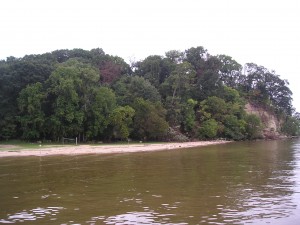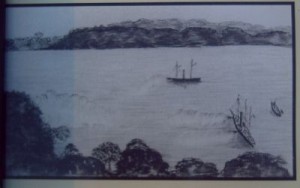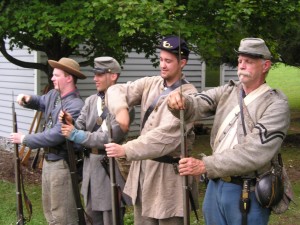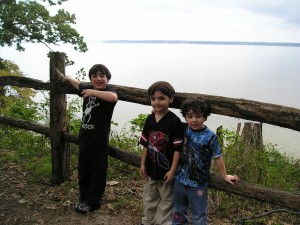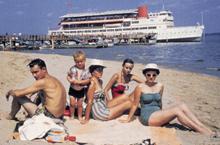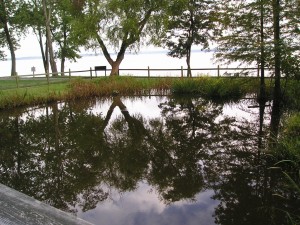What do you do if you’re the father of three rambunctious little boys, live in Northern Virginia, and the sesquicentennial of the Civil War has rolled around? You take them to plenty of Civil War reenactments and events, that’s what. Gets ’em out of the house, and maybe they’ll learn something.
This past weekend marked the 150th anniversary of the establishment of the Confederate blockade of the Potomac River following the rebel victory at the first Battle of Manassas. Confederate artillerymen mounted a small battery of four cannons at Freestone Point, meant primarily as a diversion from larger batteries which were being built upriver, closer to Washington, DC. On September 25, 1861, those four cannons exchanged fire with Federal gunboats OSS Seminole and Jacob Bell. Nobody was killed or injured on either side.
Leesylvania State Park, the present site of the Freestone Point Battery, marked the occasion with a living history reenactment. A woman in period dress invited my boys to enlist in the Confederate Army. First she looked at their teeth–they had to have at least one set of opposing teeth in front to join the infantry, so they’d be able to bite off the tops of cartridges of gunpowder. If they lacked opposing teeth in front, they’d have to go into the artillery. Levi and Judah got enlisted into the infantry; Asher, who’s been enjoying lots of visits from the Tooth Fairy recently, got shuffled over to the artillery. Four “soldiers” then gave the boys a demonstration of rifle drill, loading, and firing, which my sons expressed great enthusiasm for. I foresee myself buying one, maybe two Daisy air rifles sometime down the road.
Leesylvania State Park, which hugs the Potomac River a little north of Triangle and Quantico, Virginia, is a beautiful place with a fascinating history. The land the park occupies was originally the estate of “Light Horse Harry” Lee, the Revolutionary War hero who was the father of Confederate General Robert E. Lee. Freestone Point, a landmark within the park, became locally famous as a spot where sandstone could be easily quarried. Later, in 1861 and 1862, the bluff was selected as the site of a small battery of cannons mounted to enforce a Confederate blockade of Federal traffic along the Potomac River. Nearly a century later, in the late 1950s, the area became known as Freestone Point Park, a gambling and swimming resort. Landbased attractions included three swimming pools, one of them Olympic-sized, a Ferris wheel, a narrow gauge excursion railroad, restaurants, and bandstands for live music. There was also a mile’s worth of white sand beach and a pier which led to the S.S. Freestone, a gambling ship. As soon as a person stepped out onto the pier and over the Potomac’s waters, he or she left Virginia and entered Maryland, which made the activities on the gambling vessel legal. Here’s a quote from one of the park’s historical markers:
“‘A Pacific Paradise on the Potomac,’ suggests the type of atmosphere that existed at Freestone Point in July, 1957. The S.S. Freestone, a gambling ship, was the main attraction of an exciting new recreational resort. Even though it was illegal to either gamble of sell liquor by the drink in Virginia at this time, activity on the S.S. Freestone was protected from Virginia law by mooring in Maryland waters. The S.S. Freestone featured 200 slot machines on her deck, a finely furnished restaurant on the second, and on the third deck a cocktail lounge, in Hawaiian décor, featured live music and dancing. Formerly an excursion steamer, the ship had been retrofitted as a floating casino. Special opening day ceremonies held on July 20, 1957, included events such as the live music of Johnny Long and his Orchestra, water ballet, water skiing exhibitions, raced by sailing craft, fireworks and a beauty contest to crown the Queen of Freestone Point.”
Freestone Point Park and its gambling ship were but a memory by the mid-1960s, and the area sat fallow for a number of years before its owner donated it to the Virginia State Parks agency. Leesylvania State Park opened in 1992. One of the most imaginative and attractive reuses for an abandoned swimming pool I’ve ever seen is the park’s transformation of the old Olympic-sized pool into a reptiles and amphibians pond. The boys and I spotted bullfrogs, dozens of big tadpoles, a snapping turtle, and a red earred slider. The pond roughly retains the shape of the old, now vanished swimming pool. The old resort’s beaches, unfortunately, have mostly been eroded away by the Potomac’s tides.
A wonderful park. We’ll be going back, frequently. If only I can keep the boys from falling into the river…

